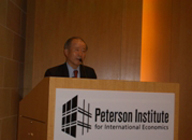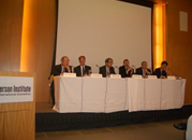Tuesday, November 27, 2007
| Date | Tuesday, November 27, 2007  |
|---|---|
| Venue | Washington DC, USA at Peterson Institute for International Economics (1750 Massachusetts Avenue, NW Washington DC 20036) |
| Sponsors | Japan Economic Foundation Peterson Institute for International Economics |
TopicsNew Asia-Pacific Trade Initiatives
A Joint Conference sponsored by the Japan Economic Foundation and
Peterson Institute for International Economics
Agenda
8:30 a.m. Registration and coffee
9:00 a.m. Welcoming RemarksC. Fred Bergsten, Peterson Institute for International Economics
Noboru Hatakeyama, Japan Economic Foundation
9:15 a.m. Session IBilateral and regional FTAs and EPAs that the US and Japan have concluded and are now pursuing with third countries (regions), and other trade initiatives in the region. To include discussion of:
- Such specific FTAs as KORUS FTA and Japan-ASEAN FTA, Japan-Malaysia FTA, CAFTA and US-Australia FTA incorporating a comparative study of the liberalization rates (including tariff elimination rates);
- Region-wide initiatives including 10+3 and 10+6 in East Asia, FTAA in the Americas and their implications for US and Japan;
- Other FTA initiatives in the region, such as China-ASEAN and Korea-EU, and Japanese and US reactions to them;
- Recent agreements between US Administration and Congress as presumed basis for future US FTAs.
Moderator: C. Fred Bergsten
Presenters (15 minutes each):
Jeffrey Schott, Senior Fellow, Peterson Institute for International Economics
Yukiko Fukagawa, Professor, School of Political Science and Economics, Waseda University
Chulsu Kim, Senior Advisor at Lee International IP and Law Group in Seoul and Chairman of Institute for Trade & Investment (ITI) (Former Minister of Trade, Industry and Energy of the Republic of Korea and former Deputy Director-General of the WTO)
10:45 a.m. Coffee Break
11:00 a.m. Session IIIssues towards the conclusion of a high quality US-Japan EPA/FTA
- Access to goods market
Elimination of tariffs: how should the liberalization rate covered under a US-Japan FTA be calculated? One idea is to make the calculation on the basis of domestic demand for each item in both countries. - Trade in Services
With respect to the service sector, should, as a general rule, the entire sector be subject to the agreement and, if so, is this possible in the US-Japan FTA? - Investment
The general rule is national treatment. Is this possible in the US-Japan FTA? - Food and energy national security
From the perspective of national security on food and energy, we will discuss export prohibitions or restrictions temporarily applied to prevent or relieve critical shortages of foodstuffs or other products essential to the exporting contracting party, based on Article 11.2 (a) of GATT. - Major hurdles
Rice and other agriculture in Japan? Autos in US? Specific services sectors in both?
Moderator: Noboru Hatekeyama
Presenters (15 minutes each):
Scott Bradford, Visiting Fellow, Peterson Institute for International Economics
Shujiro Urata, Professor of Economics, Graduate School of Asia-Pacific Studies, Waseda University
Discussants (10 minutes each):
Edward Lincoln, Director, Center for Japan-US Business & Economic Studies, New York University
Clyde Prestowitz, President, Economic Strategy Institute
Junichiro Kuroda, Special Advisor to the Ministry of Economy, Trade & Industry
(METI) and Director, JETRO New York
12:30 p.m. LuncheonSpeaker:
Wendy Cutler, Assistant U.S. Trade Representative for Japan, Korea and APEC Affairs
1:30 p.m. Session IIICreation of a Free Trade Area of Asia-Pacific (FTAAP)
- Design of FTAAP - like NAFTA (high standards) or like EAFTA (lower standards)?
- Road map to FTAAP - all-in negotiation or docking of current FTAs or plurilateral agreement of sub-APEC groupings with subsequent broadening?
- Relationship to other current or prospective megaregional agreements, especially 10+3/10+6 and FTAA.
Moderator: Chulsu Kim
Presenters (15 minutes each):
Gary Hufbauer, Peterson Institute for International Economics
Noboru Hatakeyama, Chairman and CEO, Japan Economic Foundation
C. Fred Bergsten, Director, Peterson Institute for International Economics
Discussants (10 minutes each):
Claude Barfield, Resident Scholar, American Enterprise Institute
Shujiro Urata, Professor of Economics, Graduate School of Asia-Pacific Studies, Waseda University
4:00 p.m. Conclude
Papers and PresentationsSession I Bilateral and regional FTAs and EPAs that the US and Japan have concluded and other trade initiatives in the region.Presenters:Jeffrey Schott, Peterson Institute
The FTA Frenzy in East Asia: Current Status and Prospects
Yukiko Fukagawa, Waseda University
Redesigning East Asian Integration
Chulsu Kim, Senior Advisor at Lee International IP and Law Group in Seoul and Chairman of Institute for Trade & Investment (ITI)
Korea's FTAs: Current Status and Issues
Session II Issues towards the conclusion of a high quality US-Japan EPA/FTAPresenters:Scott Bradford, Peterson Institute
An Analysis of a Possible Japan-US Trade Agreement
An Analysis of a Possible Japan-US Free Trade Agreement
Shujiro Urata, Waseda University
Japan-US EPA: Benefits and Obstacles
Session III Creation of a Free Trade Area of Asia-Pacific (FTAAP)Presenters:Gary Hufbauer, Peterson Institute
Fitting Asia-Pacific Agreements into the WTO System
Multilateralizing Regionalism Fitting Asia-Pacific Agreements into the WTO System
Noboru Hatakeyama, Japan Economic Foundation
The Creation of a Free Trade Area of the Asia Pacific
C. Fred Bergsten, Director, Peterson Institute
Toward a Free Trade Area of the Asia Pacific
ParticipantsTuesday, November 27, 2007List
SummarySummary (English)Summary (Japanese)
Chairman's SpeechOpening remarks by Mr. Noboru Hatakeyama (November 27, 2007 at JEF-PIIE Conference, Washington DC)
Dr. Fred Bergsten, Distinguished guests, Ladies and Gentlemen, it is my great pleasure to be here with you today in this important conference.
First of all, I would like to express my heartfelt gratitude to all speakers and discussants, and the participants for attending the conference in spite of your hectic schedule. Especially, I would like to thank Dr. Fred Bergsten for making the conference realized as a co-host.
Today, we will discuss a possible US-Japan FTA and the creation of a Free Trade Area of Asia Pacific. However, the environment surrounding us is not necessarily favorable to us. In Japan, for example, the DPJ, an opposition party, won the past election, pledging to give all farmers direct subsidies, thereby undermining the Japanese Government policies to limit the recipients of direct subsidies to those farmers with capacity and strong will to sustain agriculture in the years to come.
It seems to me that the ruling party, the LDP, is trying to cope with this situation. It may happen that the ruling party, the LDP, is tempted to do the similar policies. In other words, the kind of what is going down there with agricultural policy can be called the competitive protection between the LDP and the DPJ rather than the competitive liberalization.
Here in this great country, the wind might be blowing to the direction of more protection. Last month I visited China twice right after the Party Congress. Over there, there seemed to be a unanimous chorus to the effect that farmers are important, which I have never heard before.
Up until before the Party Congress, it was said that since farmers were not well represented in the People's Congress as well as in the Cabinet Meeting in the Government. The Chinese Government did not have to listen to farmers voices. This might have been why Zhu Rongi, former Prime Minister of China, could take the courageous policies to expose Chinese industries, including agriculture, to the foreign competition through participating in the WTO and committing FTAs with other countries.
Now, whether or not China can maintain same agricultural policies remains to be seen after the Party Congress with a chorus, "farmers are important."
I am quite sure that it is vitally important for both countries to realize a US-Japan FTA as well as an FTAAP. However, the hurdles, as I mentioned above, against the creation of these FTAs are getting higher and higher. Therefore, through our discussion today, it might be more than happy if we find out the wisdoms which will be able to address these new circumstances.
Thank you very much.
2017. JULY 2016. JUNE 2015. SEPTEMBER 2014. DECEMBER 2013. OCTOBER 2013. FEBRUARY 2011. NOVEMBER 2010. OCTOBER 2010. JANUARY 2008. DECEMBER 2007. NOVEMBER 2006. OCTOBER 2006. JULY 2005. SEPTEMBER 2004. MAY 2003. OCTOBER
